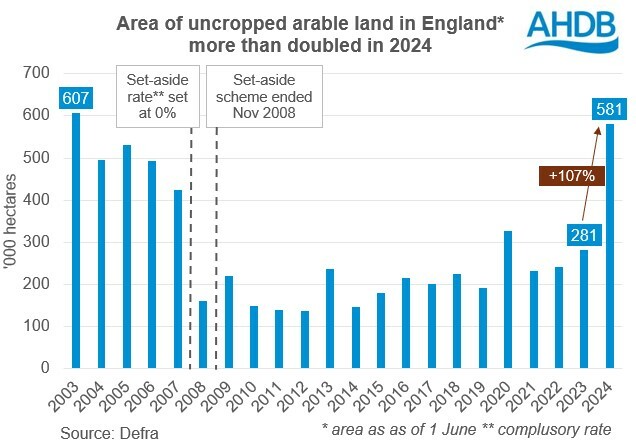Highest uncropped arable area in England since 2003: Grain market daily
Friday, 27 September 2024
Market commentary
- UK feed wheat futures for Nov-24 closed at £183.05/t yesterday, up £1.05/t over the day, while the Nov-25 contract lost £0.40/t to settle at £195.10/t.
- Wheat markets rose earlier in the day on concerns about slow winter wheat planting in Russia. Heavy rain in parts of the EU is also being monitored, along with speculation that Russia may introduce export quotas in the latter part of the season. However, later in the day US wheat futures fell amid slower than expected export sales, and re-positioning by speculative traders.
- Global oilseed futures dipped yesterday after hitting multi-week highs on Wednesday. Paris rapeseed Nov-24 futures lost €5.00/t to close at €475.00/t, while the Nov-25 contract closed at €468.75/t, down €2.00/t.
- Re-positioning by speculative traders ahead of the quarter-end and US stocks data on Monday brought pressure to US soyabean futures. Weaker crude oil futures and better weather for harvesting canola in Canada were also in focus. However, concerns about ongoing dry weather in Brazil limited losses.
Highest uncropped arable area in England since 2003
Defra reports the largest uncropped arable area in England since 2003; AHDB confirms harvest 2024 is in its closing stages.
Uncropped arable area soars
Unsurprisingly, after the extremely challenging weather through autumn 2023 and spring 2024, Defra reports a sharp rise in uncropped arable land in England this year. At 580.7 Kha, the 2024 area is more than double the level in 2023 and the highest level in 21 years (since 2003).

For the first time, Defra has also provided a breakdown of ‘uncropped arable land’ into ‘bare fallow’ and ‘Arable land used for environmental benefit but not in production’. The latter category includes pollen and nectar flower mixes, winter bird food, buffer strips on arable land, flower rich margins and in field strips. Bare fallow area in 2024 is estimated at 275.7 Kha, while the area of arable land used solely for environment benefit is estimated at 305.0 Kha.
This statistic gives some insight into the level of land withdrawn from production for the Sustainable Farming Incentive (SFI).
The estimate of productive land not being used equates to 6% of the ‘total croppable area’ in England. On the face of it, this could negatively impact grain and/or oilseed production.
However, any land submitted into these schemes is likely to be the poorer performing land or replacing crops that have persistently struggled to establish. AHDB analysis showed it is only worth replacing break crops with the SFI action of planting a herbal ley or legume fallow if they are prone to consistent crop failure. This will help minimise the impact on production, as was seen during the set-aside years. Also, it’s not clear which crop(s) the area switches from within the ‘total croppable area’ category.
The publication of this data gives a useful benchmark for future years.
We’ll be discussing the impact of SFI and government policy on grain and oilseed markets on 5 November 2024 in Birmingham. Book your place at AHDB’s Grain Market Outlook briefing: SFI and the UK cereals and oilseeds market – Friend or foe?.
Harvest into closing stages
Harvesting is now into the closing stages shows AHDB’s latest harvest progress report, after a period of drier weather in mid-September supported progress. Only small areas in Scotland and the North East of England remain for spring barley, plus there’s small amounts of spring oats in Scotland still to be cut.
The wheat harvest is all but completed across the UK, except in Scotland, by the week ending 25 September. In Scotland, the wheat harvest is 96% complete.
Rainfall over the past few days has slowed progress again and the focus will be on preserving quality, where possible, in later harvested crops.
Sign up to receive the latest information from AHDB.
While AHDB seeks to ensure that the information contained on this webpage is accurate at the time of publication, no warranty is given in respect of the information and data provided. You are responsible for how you use the information. To the maximum extent permitted by law, AHDB accepts no liability for loss, damage or injury howsoever caused or suffered (including that caused by negligence) directly or indirectly in relation to the information or data provided in this publication.
All intellectual property rights in the information and data on this webpage belong to or are licensed by AHDB. You are authorised to use such information for your internal business purposes only and you must not provide this information to any other third parties, including further publication of the information, or for commercial gain in any way whatsoever without the prior written permission of AHDB for each third party disclosure, publication or commercial arrangement. For more information, please see our Terms of Use and Privacy Notice or contact the Director of Corporate Affairs at info@ahdb.org.uk © Agriculture and Horticulture Development Board. All rights reserved.


